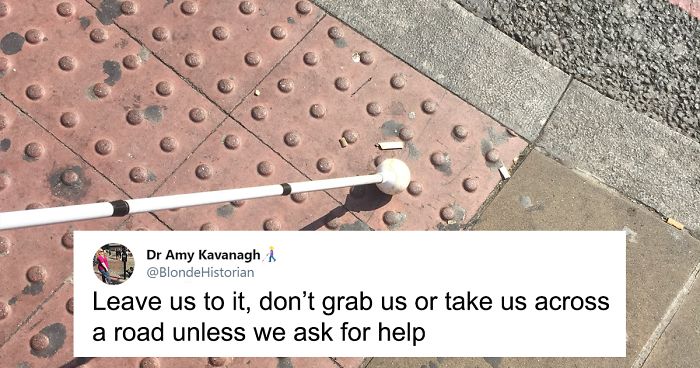
Woman Educates People On Barriers Blind Individuals Experience By Sharing Some Key Information On Tactile Paving
In 1965, a man named Seiichi Miyake came up with a groundbreaking idea that was soon to change the lives of millions of people all around the world. This was the year when Seiichi created the first-ever tactile bricks, which have patterns of raised shapes on their surfaces that can be detected by touch, and called this innovation tactile paving. Seiichi was determined to create something like this because he had a good friend who was starting to lose his vision and Seiichi wanted to make his friend’s life at least a little bit easier. This one noble goal singlehandedly changed the way visually impaired people navigate streets in their day-to-day lives.
Even though tactile paving was invented more than 50 years ago, a lot of people to this day have no idea how visually impaired people navigate using it. Fortunately, a visually impaired activist named Amy Kavanagh created a Twitter thread that explains the secret language of tactile pavement in a perfect way.
Bored Panda invites you to carefully examine Amy’s tweets and use this opportunity to educate yourself about visual impairment and the barriers that blind people have to face in their everyday lives.
More info: Twitter | Facebook | caneadventures.blog
Amy begins by telling us about red tactile paving
Image credits: BlondeHistorian
“To deal with the challenges of my daily commute, I rely on something you probably never even noticed before. Like most visually impaired people, I have some useful vision. On a good day, it’s up to a couple of metres in front of me. It’s like being in a bubble. Beyond the bubble life is blurry, wobbly, a mix of shapes and colours,” Amy Kavanagh wrote in her article on BBC News.
Image credits: BlondeHistorian
“On a bad day—when it’s very sunny, I’m tired or stressed—my bubble shrinks. I can’t read my phone or see a traffic light, sometimes everything is just a blur,” Amy wrote in her article. “I was born visually impaired so I’ve always navigated the world differently. Instead of relying on my vision, I use my hearing, sense of smell, and touch, but also my memory.”
On her blog called Cane Adventures, Amy shares that the decision to use a cane was a long, difficult process of self-acceptance. “Using a cane means that you are really accepting that you can’t see and that you do find some things difficult. Initially, it felt like sticking a great big BLIND label on myself, but soon that label didn’t feel at all problematic,” Amy wrote in a post on her blog.
Image credits: BlondeHistorian
“I use a cane technique called constant contact. This means that I sweep my cane along the ground and maintain contact at all times. This enables me to feel changes in the surface, any curbs or steps, as well as tactile paving and it finds objects that I might bump into,” Amy writes on her blog.
And now let’s take a look at the yellow ones
Image credits: BlondeHistorian
“As a new cane user, one of the most important lessons was how to use tactile pavements. Those bumps, lumps and stripes give me so much information, especially on days when my vision is more limited,” Amy writes in her article on BBC News. “Tactile paving is particularly useful at road crossings. The bumpy blister paving not only tells me that there is a road crossing but what kind of crossing to expect.”
Image credits: BlondeHistorian
In her article on BBC News, Amy wrote that the best thing about tactile paving is that it provides visually impaired individuals with clues about the environment they’re in, especially when it’s an unfamiliar one. “It tells me when to be aware of potential hazards, like platform edges or cycle lanes. Without it, I take a lot longer to find my way and often rely more on someone else to help me,” Amy wrote.
Image credits: BlondeHistorian
Image credits: BlondeHistorian
If you notice tactile paving that needs repair, make sure to report it!
Image credits: BlondeHistorian
Image credits: BlondeHistorian
In fact, there are a few different ways to navigate using tactile paving
Image credits: BlondeHistorian
One more note—before proceeding to help a visually impaired individual, make sure that they actually need help
Image credits: BlondeHistorian
And as with everything, there’s still a lot of improvement to do
Image credits: BlondeHistorian
19Kviews
Share on FacebookSo THAT'S what those things are for! I thought they were for rainy days, so your feet have a better grip, or something.
Same, until Now! I never paid attention to the fact that different types of crossings have the bumps arranged differently either
Load More Replies...My adult niece is blind. It's amazing how she navigates the world, especially when most of the world does not accommodate her in any ways. She was at a conference for the blind, and they discovered that all the Braille room number plaques were on upside down, throughout the entire hotel, including conference rooms.
I used to work for the RNIB (Royal National Institute of Blind People) and as you would expect the buildings were well set up to accommodate the needs of the many blind people getting about. However, one day it was discovered that someone had gone to the trouble of picking off the bumps from the braille on the lift buttons. Who the hell would do something like that??!!
Load More Replies...Some people have some sight, so they would be able to see the different colours. Like the woman in this thread, she can see a few metres ahead she said.
Load More Replies...I can't believe this isn't something more readily taught to people who aren't visually impaired. I'd never heard of any of this! I would never know not to block particular spots so they can navigate appropriately.
These are all on crossings and areas which you wouldn't be allowed to block anyway - if that's any comfort. Though shops or homeowners putting things out on pavements unexpectedly is a massive problem.
Load More Replies...I wonder if these rules are international? Last place I lived, they used the corduroy ridge tiles to lay out "lanes" you could follow from e.g. the centre to the train station. No stairs or hills in sight. Also, I always trip on these things... >.<
These are all great. But the ones at supermarkets that help prevent carts from going into the street are my bane. It is physically painful for me to push a cart over those bumps. I generally just shove the cart really hard and let go entirely. It stops before it gets thru, but it reduces the jolting pain on my arms.
Just to clarify but It says @BlondeHistorian. Sorry, appreciate it is probably autocorrect. 🙂
Load More Replies...My comment may belong in the stupid people post. I'd noticed these at crosswalks and ramps and thought they were anti slip measures. I'll look st them differently now.
I did too. Which was puzzling, as they actually can make crossing more difficult for people in wheelchairs. I used to dislike them because of the increased difficulty in adequately clearing ice and snow from them, but now that I know how they are intended to be used, I view them differently.
Load More Replies...Posting screenshots of the tweets made this information less accessible to visually impaired people. Screen readers can't read images. I know the intent was to share this info with non-VI people, however there may be VI people who would benefit from this info too.
Twitter is actually quite good - they've worked to make the site accessible with audio description of images as well as use of JAWS software which provides braille and speech output. All companies have the option of working with organisations such as RNIB to improve accessibility on their websites. Even Bored Panda.
Load More Replies...So THAT'S what those things are for! I thought they were for rainy days, so your feet have a better grip, or something.
Same, until Now! I never paid attention to the fact that different types of crossings have the bumps arranged differently either
Load More Replies...My adult niece is blind. It's amazing how she navigates the world, especially when most of the world does not accommodate her in any ways. She was at a conference for the blind, and they discovered that all the Braille room number plaques were on upside down, throughout the entire hotel, including conference rooms.
I used to work for the RNIB (Royal National Institute of Blind People) and as you would expect the buildings were well set up to accommodate the needs of the many blind people getting about. However, one day it was discovered that someone had gone to the trouble of picking off the bumps from the braille on the lift buttons. Who the hell would do something like that??!!
Load More Replies...Some people have some sight, so they would be able to see the different colours. Like the woman in this thread, she can see a few metres ahead she said.
Load More Replies...I can't believe this isn't something more readily taught to people who aren't visually impaired. I'd never heard of any of this! I would never know not to block particular spots so they can navigate appropriately.
These are all on crossings and areas which you wouldn't be allowed to block anyway - if that's any comfort. Though shops or homeowners putting things out on pavements unexpectedly is a massive problem.
Load More Replies...I wonder if these rules are international? Last place I lived, they used the corduroy ridge tiles to lay out "lanes" you could follow from e.g. the centre to the train station. No stairs or hills in sight. Also, I always trip on these things... >.<
These are all great. But the ones at supermarkets that help prevent carts from going into the street are my bane. It is physically painful for me to push a cart over those bumps. I generally just shove the cart really hard and let go entirely. It stops before it gets thru, but it reduces the jolting pain on my arms.
Just to clarify but It says @BlondeHistorian. Sorry, appreciate it is probably autocorrect. 🙂
Load More Replies...My comment may belong in the stupid people post. I'd noticed these at crosswalks and ramps and thought they were anti slip measures. I'll look st them differently now.
I did too. Which was puzzling, as they actually can make crossing more difficult for people in wheelchairs. I used to dislike them because of the increased difficulty in adequately clearing ice and snow from them, but now that I know how they are intended to be used, I view them differently.
Load More Replies...Posting screenshots of the tweets made this information less accessible to visually impaired people. Screen readers can't read images. I know the intent was to share this info with non-VI people, however there may be VI people who would benefit from this info too.
Twitter is actually quite good - they've worked to make the site accessible with audio description of images as well as use of JAWS software which provides braille and speech output. All companies have the option of working with organisations such as RNIB to improve accessibility on their websites. Even Bored Panda.
Load More Replies...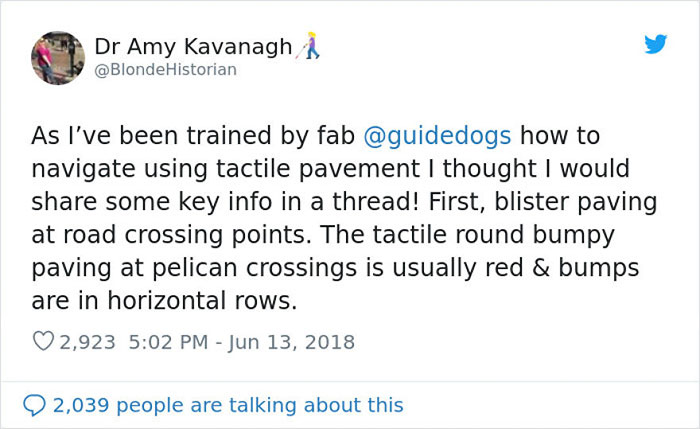
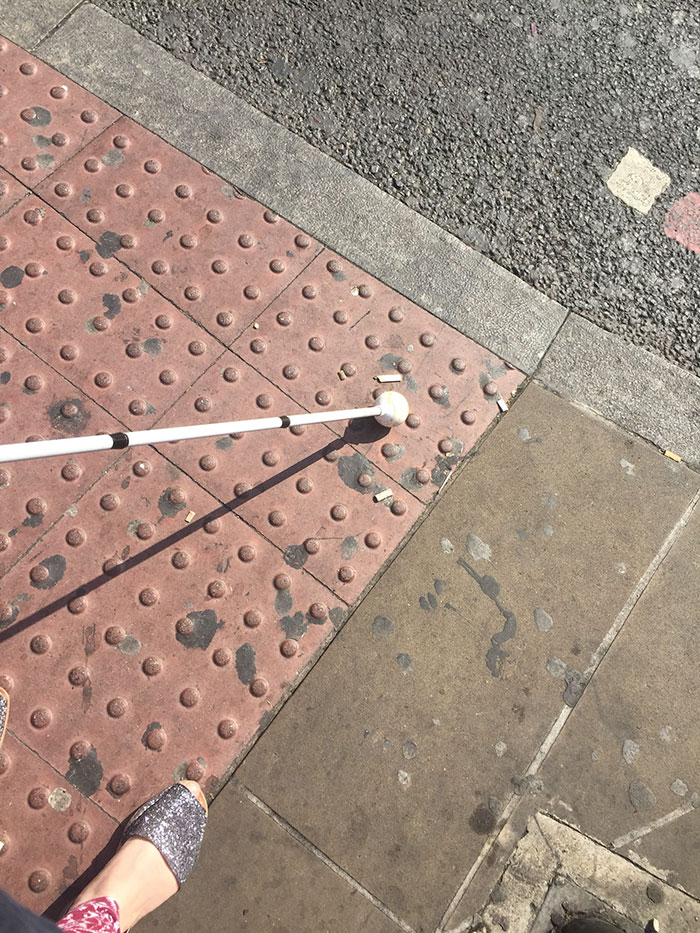
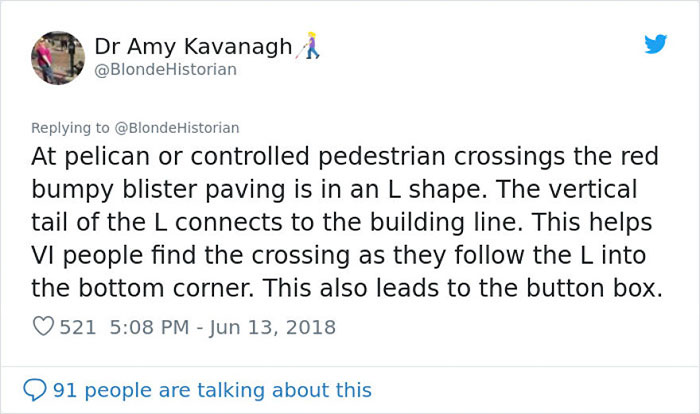
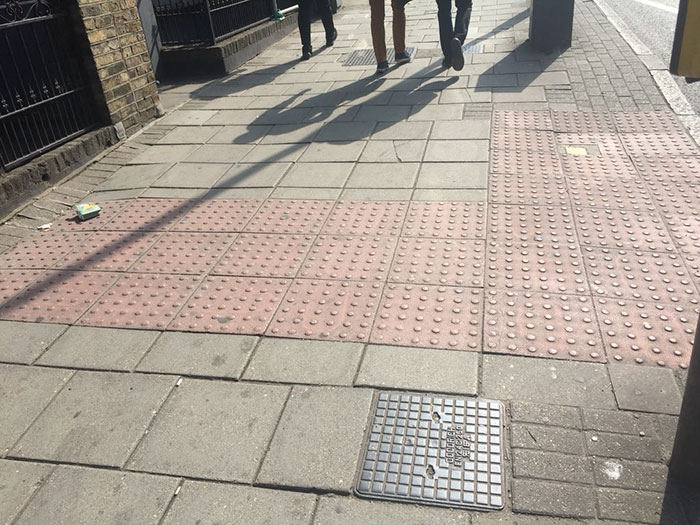
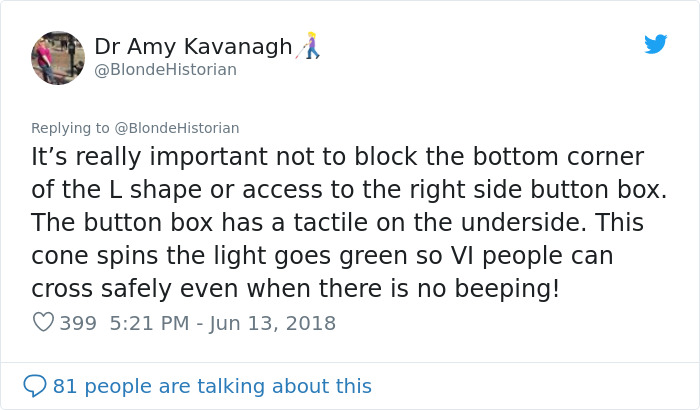
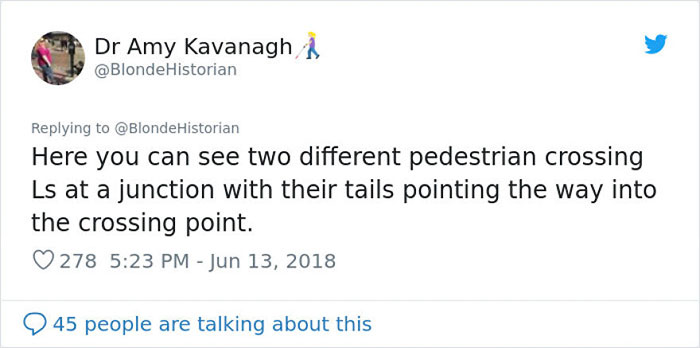
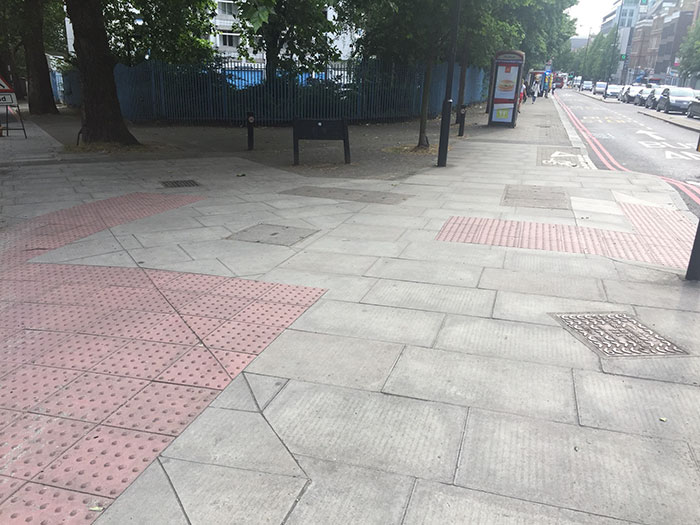
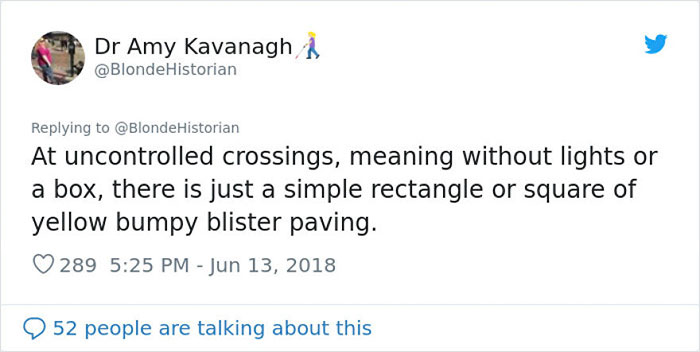
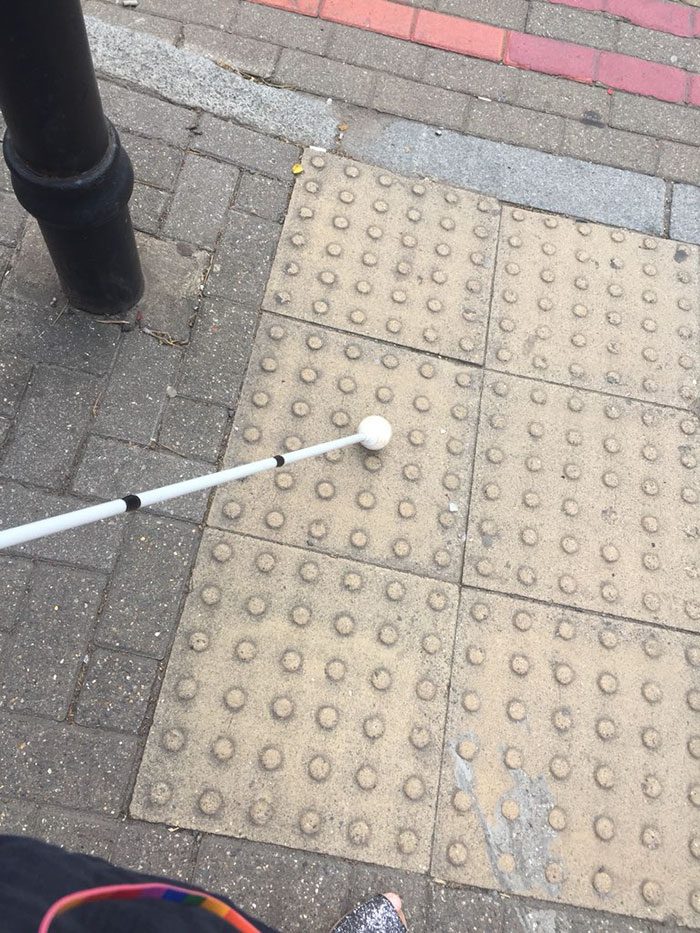
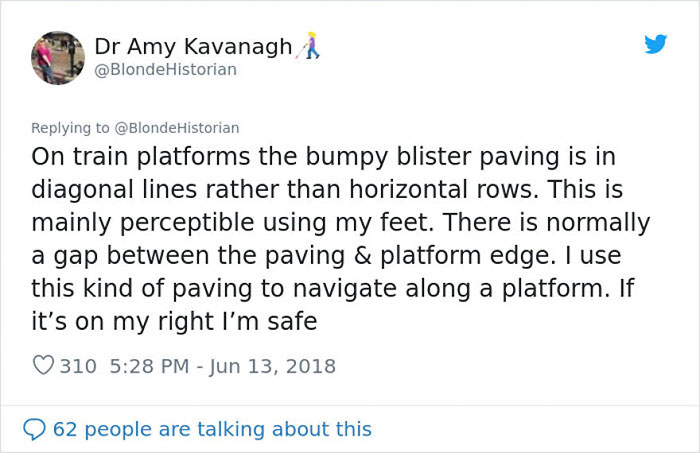
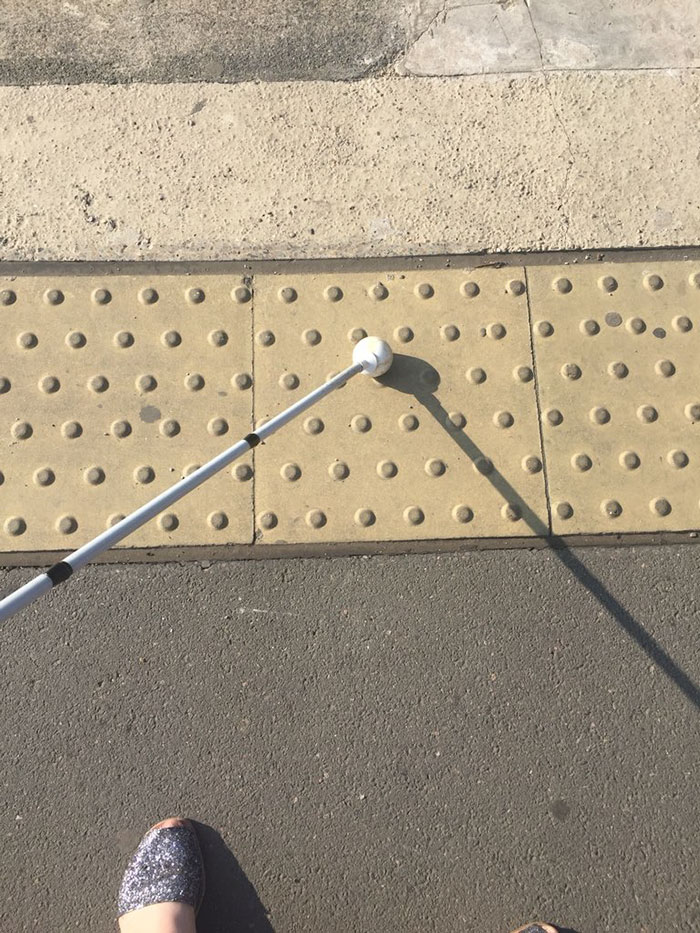
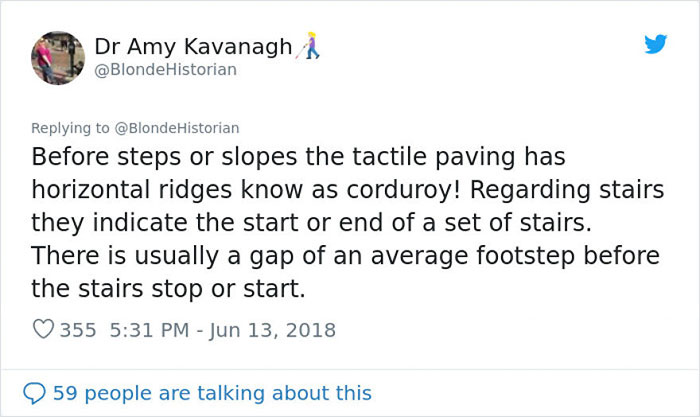
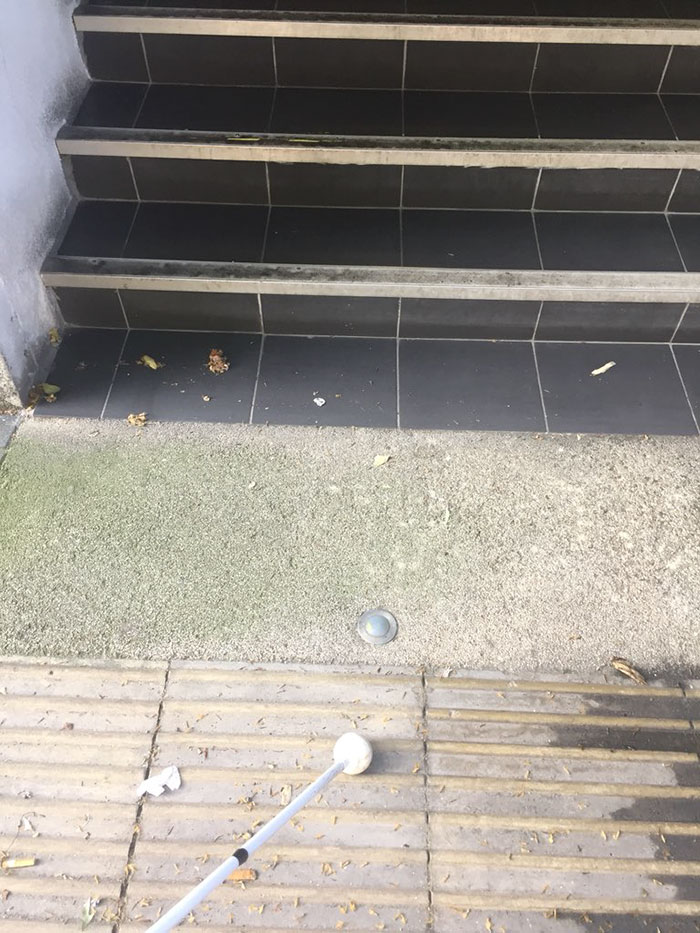
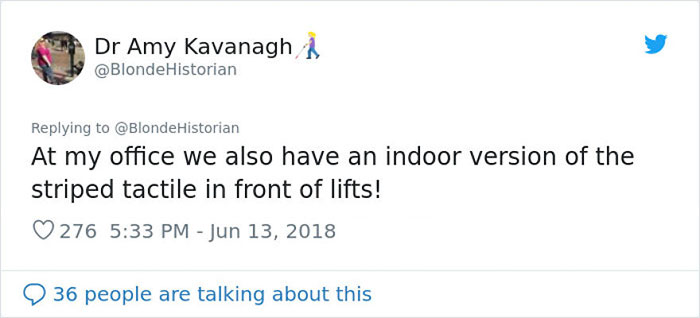
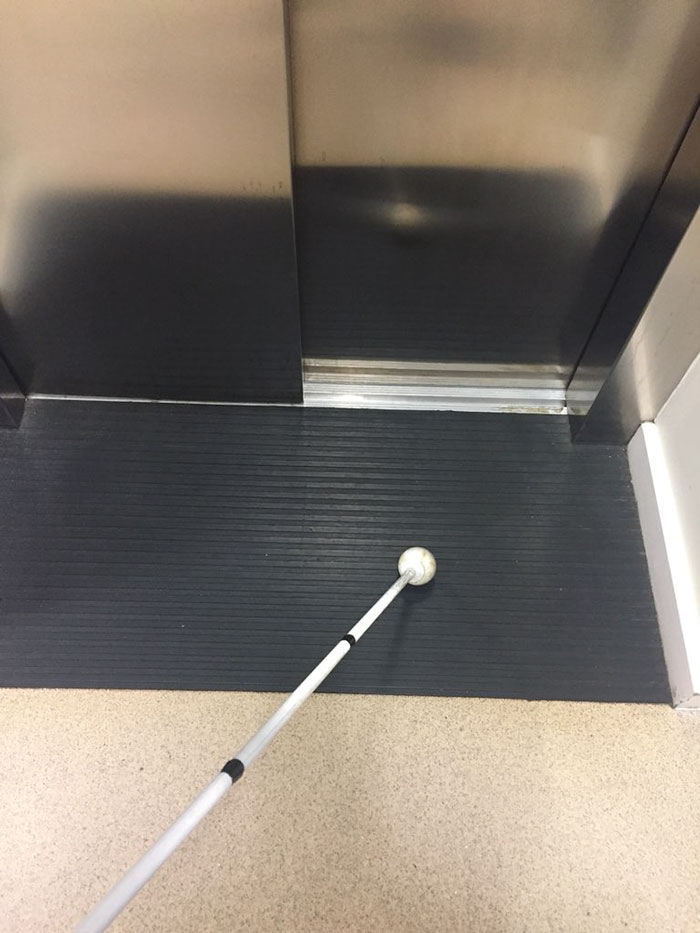
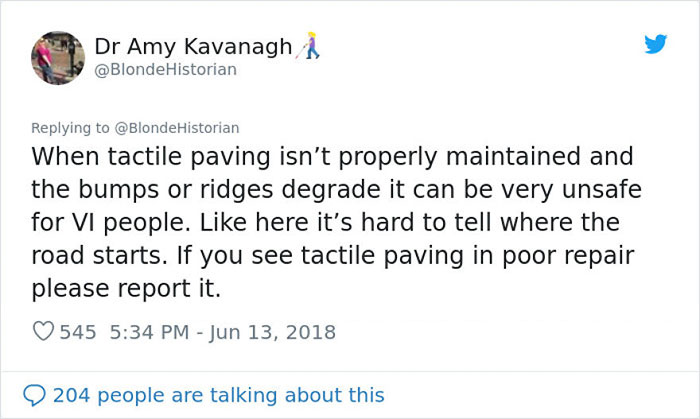
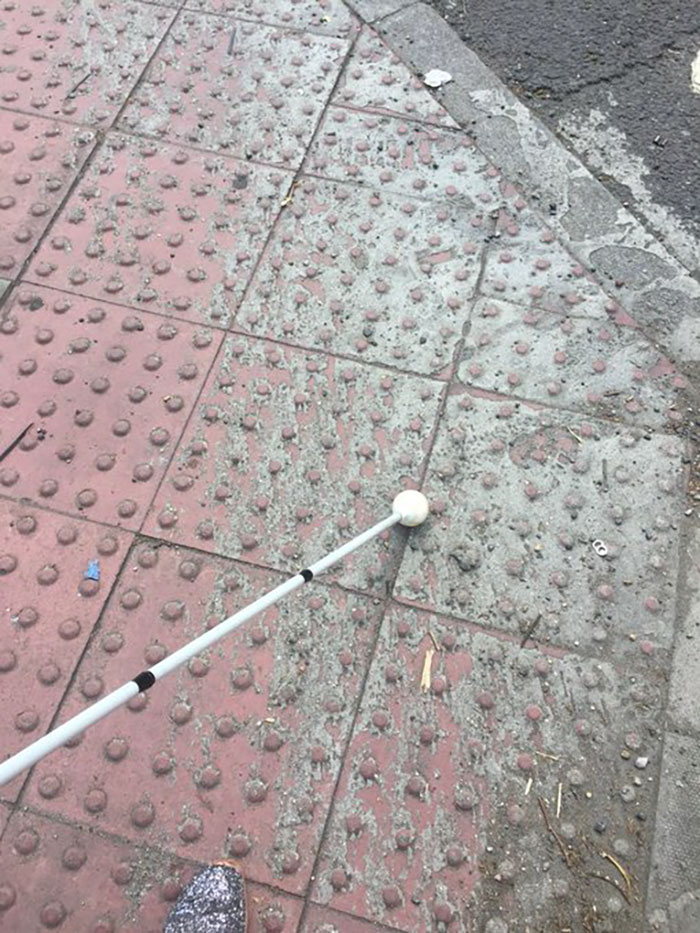
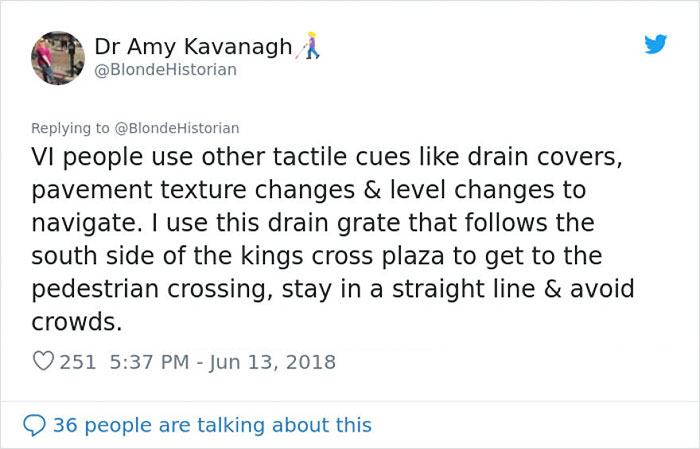
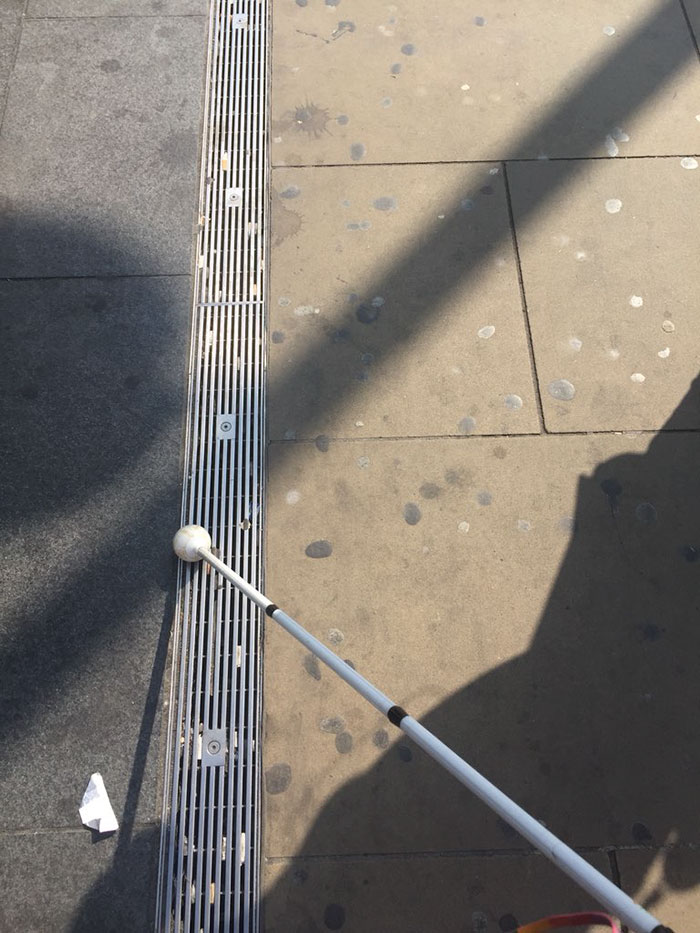
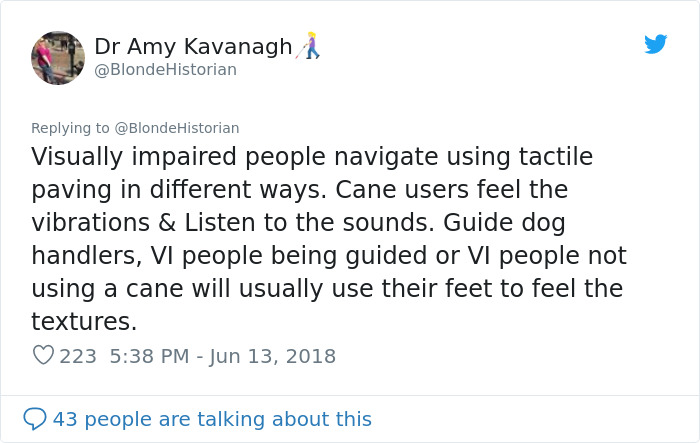
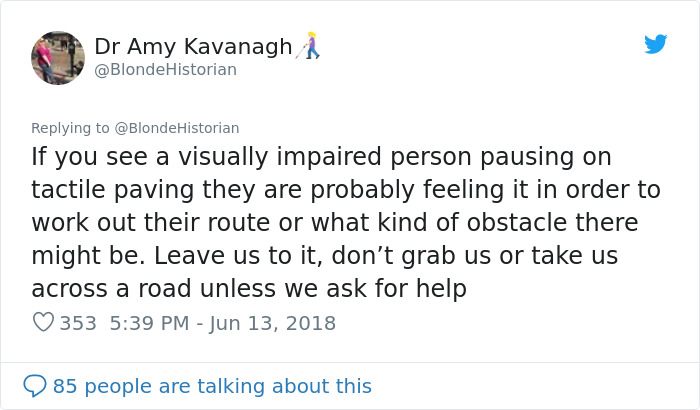
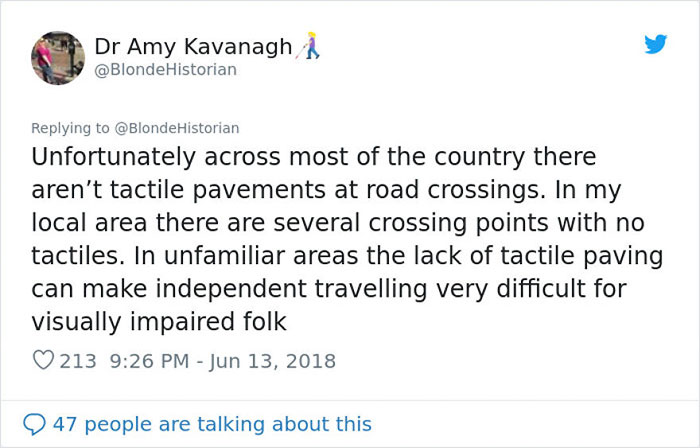
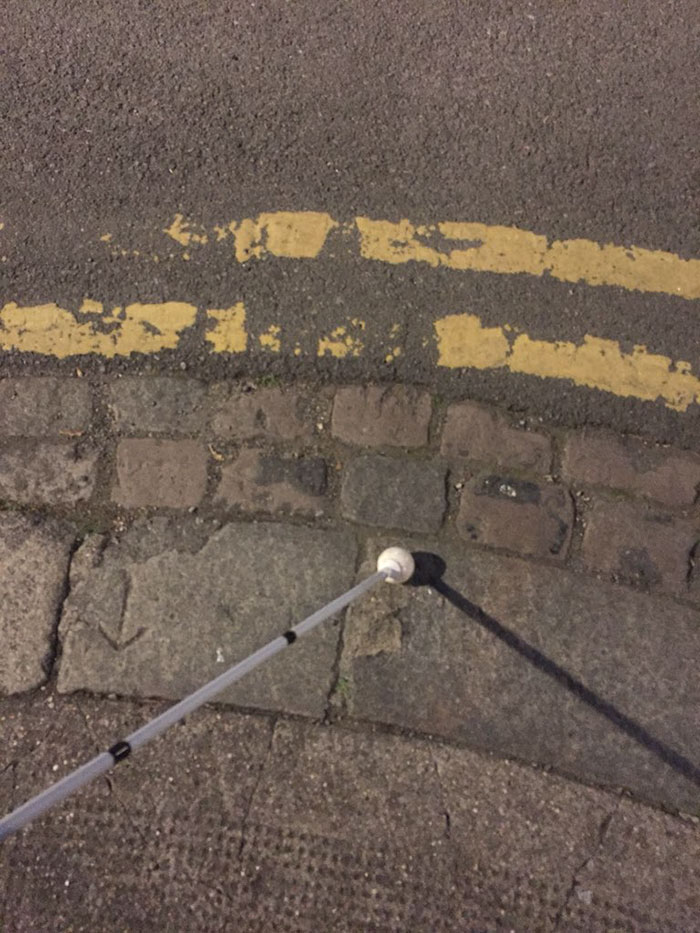



136
42